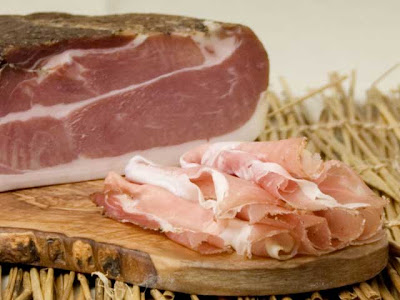Canederli is the Italian name given to the bread dumplings so popular in Austria and other parts of central Europe, known in German as Semmelknödl or just knödel. During my years in Vienna it was one of my favorite things to eat, so when I re-discovered them in Italy, on a visit to an old friend from Paris who had wound up living in Bolzano, a city in the German-speaking region of Alto Adige (aka Südtirol) in northwestern Italy, I was delighted. Not only did they bring back fond memories—they were probably the best I had ever eaten! (No offense to my Austrian friends...)
In any event, you don't need to travel to Austria or northwestern Italy to enjoy these dumplings. They are quite easy to make at home. The technique is a bit like making potato dumpling or gnocchi, but actually easier. These bread dumplings are much less prone to becoming stodgy as gnocchi can be if not made right. And it's a great way to use old bread, a nice change when you're not in the mood for a bread soup like ribollita or pappa al pomodoro.
Ingredients (for 4-6 servings)
300g (3/4 lb.) stale bread, cut into cubes
100g (1/4 lb.) speck or other cured pork product (see Notes), finely minced (optional)
2 eggs
A glass of milk
1 medium onion, finely minced
2 Tbs. flour (or more)
Parsley, finely minced
Salt and pepper
Directions
Toss together in a large bowl the bread and speck (if using), then add the eggs and milk and parsley. Mix together. Let the mixture rest for a good 20 minutes or so. The bread should be rather moist at this point, but not soaking wet. If you find the mixture a bit dry, then add more milk.
Mix in the flour, along with the onion and parsley. (NB: For added flavor, you can sauté the onions in a bit of butter before adding them to the mix.) Season well with salt and pepper.
Now form the resulting 'dough' into balls about the size of golf balls.
By the way, if the mixture does not hold together, or if you notice that it is exceedingly wet, then add more flour, a bit at a time, until you find that the mixture has reached a nice dough-like consistency that will hold together well.
Now bring a pot of well-salted water (or, for a richer taste, broth) to a gentle simmer. Add the canederli, one at a time, with a slotted spoon—or just use your hands like I usually do... If you are not experienced with making these dumplings, just form one ball to begin with, and try simmering it. If it falls apart, then you know you need to add some more flour to your mixture. Then try again with another. If all goes well, then add all the rest.
Simmer the canederli for about 15 minutes. They should have come to the surface of your simmering liquid, much as gnocchi do.
NOTES: There are various ways to serve canederli. The simplest is the way I had them at that wonderful meal in Bolzano: in a rich, homemade broth—a kind of Italo-Austrian matzo ball soup. My personal favorite way to enjoy canederli is to accompany them with a creamy mushroom sauce as pictured above, the same kind of sauce that goes so well with potato gnocchi. Also very good, and very popular in Vienna, is to serve them with beef goulash, which I hope to blog on some time quite soon.
Unlike pasta or gnocchi, however, you do not generally pour the sauce over or mix it with these dumplings, but rather lay down a 'bed' of your sauce and lay the dumplings on top. They are big enough that you will need to cut them into bite-sized pieces with a knife and fork, using your fork to fare la scarpetta as they say in Italian: dip each piece of dumpling in the sauce.
You can also make one big dumpling of the bread mixture, by forming a loaf and wrapping it in cheesecloth before simmering it. Of course, this big dumpling will take a bit longer, say 20-30 minutes, to cook. You serve it sliced like a meatloaf.
Speck is a smoked pork product that is common to Austria and this part of the Italy. It is quite delicious but can be hard to find. Feel free to substitute prosciutto or even slab bacon if you like, or omit the meat altogether, as I often do anyway.
By the way, Alto Adige, or Südtirol, is one of the most beautiful areas of Italy. It has an Alpine landscape reminiscent of nearby western Austria. In fact, it was once a part of Austria, ceded to Italy after Austria's defeat in the First World War. (It was nearby that my grandfather fought and won his posthumous medal and picked up his taste for polenta—which is why we ate that northern dish in our southern Italian family.)
In any event, the region today still retains much of its Austrian heritage, notwithstanding the best efforts of Mussolini, who 'shipped' in many Italians, especially from southern Italy, to colonize and, to his mind, 'civilize' the place. There is, in fact, a triumphal arch built by Mussolini in downtown Bolzano, the capital of the area, to celebrate the Italianization of the area. It is still the object of the occasional sabotage attempt, or so I was told when I visited, although the region was granted considerable autonomy after the Second World War. And when I was there in the late 90s the place seemed as tranquil as any I've ever been to. Besides beautiful scenery and great food, they make wonderful wines, including the popular pinot grigio, but also some excellent Chardonnays, Riesling, Sylvaner, Gewurztraminer, and Kerner. It's well worth a visit.
 |
| Beautiful Alto Adige-Südtirol |
